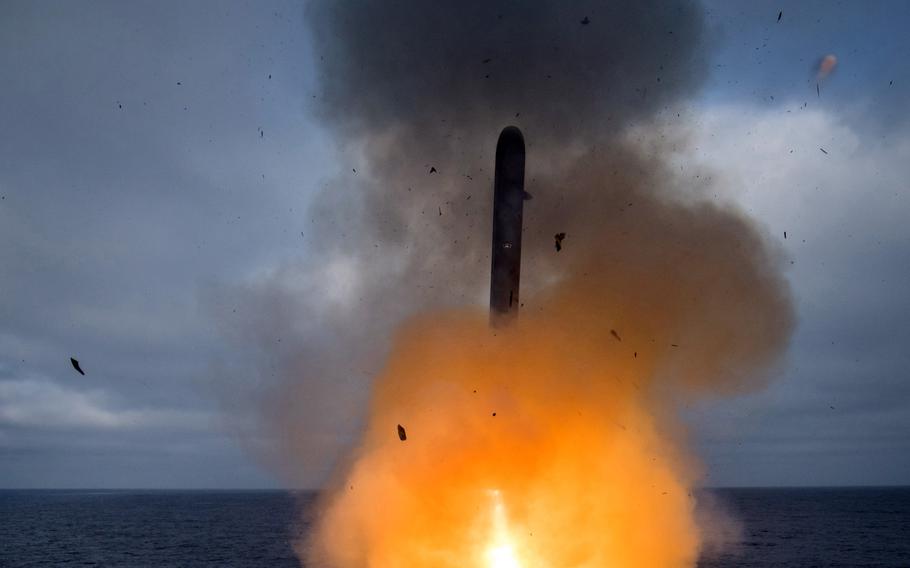
A Tomahawk missile launches from the guided-missile destroyer USS Dewey somewhere in the Western Pacific, Aug. 16, 2018. (Devin Langer/U.S. Navy)
TOKYO — The United States is not ready to deploy a variety of new missiles in Japan, contrary to a recent newspaper report, the country’s Ministry of Defense said this week.
The U.S. is developing new missiles but it’s too early to consider where to deploy them, Japanese officials were told by their U.S. counterparts, according to a ministry statement emailed Monday to Stars and Stripes.
The ministry was responding to a report Saturday by the Sankei newspaper, citing multiple anonymous U.S. and Japanese sources, that the U.S. government had suggested deploying medium-range, hypersonic and Tomahawk missiles to Japan’s southern island of Kyushu.
Tensions are rising near Japan’s southern islands amid a Chinese military buildup and its claims on Taiwan, about 700 miles south of Kyushu. Beijing considers democratic, self-governing Taiwan to be a breakaway province that must be reunified with the mainland, by force if necessary.
U.S. Forces Japan had no comment on the Sankei report, USFJ spokesman Air Force Maj. Thomas Barger said in an email Monday.
“We continuously work closely with our Japanese Ally to ensure we maintain capabilities necessary to uphold our treaty obligations of mutual security and cooperation,” he said. “U.S. Forces in Japan continue to train and posture in order to remain ready for any potential future crisis or contingency.”
The Sankei article runs counter to a Jan. 23 report by the Yomiuri newspaper — also citing unnamed U.S. and Japanese sources — that said American missiles would not be deployed to Japan.
Tokyo approved a national security strategy in December that includes acquiring counterstrike capabilities to attack enemy bases with missiles. That led Washington to forgo deployment of its own missiles, the Yomiuri report said.
The U.S. military does not operate ground-launched missiles with a range between 310 and 3,400 miles. The weapons were banned in 1988 under the U.S.-Russia Intermediate-Range Nuclear Forces Treaty, which expired in 2019.
Medium-range ballistic missiles travel between 620 and 1,860 miles, according to The Center for Arms Control and Non-Proliferation website.
However, the U.S. Army recently took delivery of a prototype Typhon Weapon System, which is intended to fire missiles at ranges between 300 and 1,725 miles.
The system, armed with SM-6 and Tomahawk missiles, is intended to hit targets at ranges between the Army’s Precision Strike Missile, about 300 miles maximum, and the developmental Long-Range Hypersonic Weapon system, about 1,725 miles maximum, Naval News reported Dec. 5.
“The [Marine Corps] is also looking at land-based Tomahawk and SM-6 missiles launched from trailers,” the news site reported.
Beijing has more than 1,900 ballistic missiles that can reach Japan, according to a 2022 Pentagon report on China’s military capabilities.
U.S. withdrawal from the INF treaty meant inevitable talk of deploying missiles in Japan, according to James Brown, an international affairs expert at Temple University’s Japan campus.
“One of the reasons for withdrawal from the INF Treaty was to enable the US to deploy ground-based intermediate range missile(s) in Asia as a means of countering China's large advantage in this category of weapon,” he said in an email Monday.
Kyushu is a logical spot for the missiles given that the East China Sea is a focal point for tension between the U.S. and China, Brown said. There are also limited alternatives, he said.
“Guam is too far,” he said. “In South Korea, it would provoke too much public backlash. And Taiwan is not yet an option. Okinawa is also a possibility but there is a widespread feeling, especially on Okinawa itself, that US deployments within Japan should be spread more evenly. “
Missiles won’t arrive any time soon, Brown predicted.
“Rather, I imagine the Japanese government is quietly raising this idea as a trial balloon as a means of gauging the public reaction,” he said.
U.S. policy toward China will be aggressive after the downing Saturday by an F-22 fighter of a Chinese spy balloon, according to Riki Ellison, founder of the Missile Defense Advocacy Alliance.
Deployment of missiles to Japan enables U.S. and Japanese forces to distribute launchers, which could be placed on other small islands in the Far East, he said by email Monday.